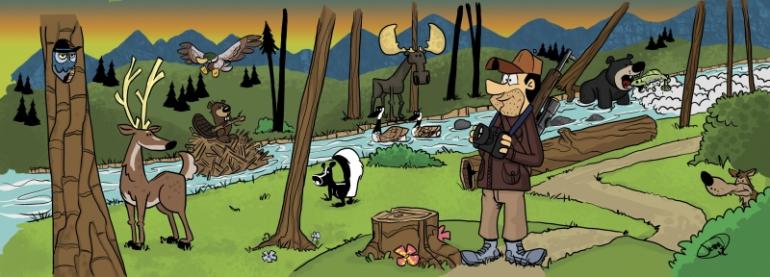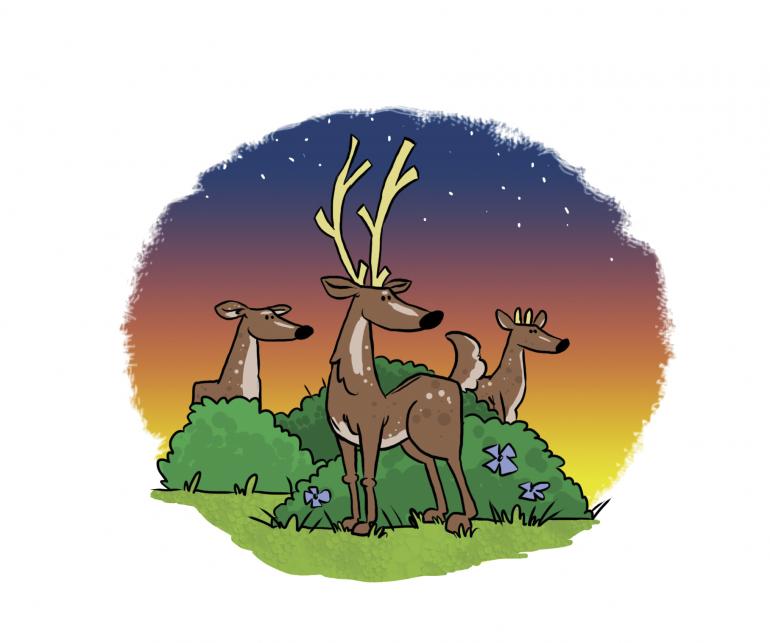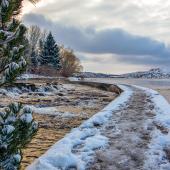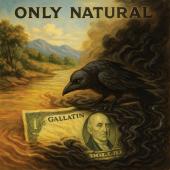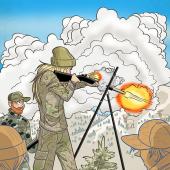Hunting the Bottoms
Half a mile below Axtell Bridge, as I stalked the wily fall foliage with my Nikon, a fisherman burst out of the brush. Big-eyed and breathless, his creel flopping and waders swishing, he hustled over to me shouting, “Did you see it?”
“What?” I asked, worriedly looking around in case “it” had big teeth, a bad temper, and a grievance with stringy old men.
“A black bear. A really big black bear.”
Well, I hadn’t seen the bear, but I wasn’t surprised the fisherman had spotted one along the Gallatin.
The Gallatin River bottoms, which stretch from approximately the mouth of Gallatin Canyon all the way to the headwaters of the Missouri, are a wildlife paradise. Besides the occasional black bear, mule deer, coyote, and moose, the bottoms teem with geese, various ducks, whitetail deer, and cottontail rabbits. Beavers dam the tributaries, bald eagles patrol the river, and a few years ago I saw a pair of moose lumber through Forest Park, that 100-plus trailer court on the Gallatin just north of Shed’s Bridge. A rancher I know loses the occasional sheep to mountain lions that skulk down feeder draws, and I’d be willing to bet that now and then a wolf makes a sweep along the upper reaches.
Myself, I don’t hunt much anymore—not that I’m opposed, but somewhere along the way I lost the desire. Back in the day, though, I bagged mallards getting up out of the hot springs that dot the river, dropped sharp-tailed and ruffed grouse out scrabbling for gravel between the high-water marks, and gobbled more than my share of rabbit stew.
On the other hand, despite various tree stands (recommended), blinds (recommended), and hundreds of hours of stalking (only if related to winged Mercury), I never did shoot the humongous whitetail buck I often hunted until late in the season.
I saw a few though. Walked right into a couple of Boone-and-Crockett monsters during a snowstorm and stood there with my mouth open. Looked like they had rocking chairs on their heads. They didn’t even bolt. They ghosted back into the storm, leaving me to ponder my slug-like reaction time and possibly flawed psychology. Maybe I was deceiving myself. Maybe I had no intention of shooting something so magnificent.
Others have done better. A fellow who hunted downriver from me shot a respectable buck from a thirty-something Ford pickup moldering in the brush, and my friend Don put a razor tip clean through a big buck’s heart. Not knowing he was dead, the buck sprinted 30 yards before crashing into a cottonwood. After he’d field dressed the big guy, Don started dragging. The heavy buck wore him out. Don drove home and fetched his wheelbarrow. Rolled the buck up to a farm road and loaded him in the bed of his pickup.
Inspirational tales aside, hunting mature whitetails in the bottoms isn’t easy. The brush ranges from thick to impenetrable, landowner permission is essential, and the big boys are shrewd as foxes. Since I’m at peace with my failures (i.e., have no shame), I don’t mind rehearsing a few of my misadventures.
Like the time I shivered in a rickety tree stand for hours only to hear a subtle crackling behind me. When I glanced over my shoulder, I discovered a good-looking buck eyeing me from a stand of aspens gussied up in gold doubloons. Before I could turn around, he was gone. And then there’s the sun-slanting late afternoon I was hiking to my blind, boogying down a damp, willow-lined channel gouged by the runoff, when I noticed some very big and very fresh tracks going in the opposite direction. I backtracked 20 yards and discovered where Bigfoot had jumped into the brush when he’d heard me coming. That sucker watched from ten feet away as I walked on by.
Although my sixth sense clearly deserted me on those two occasions, more than once I’ve lurked in a blind with squirrels scampering over my legs and mosquitoes buzzing around my head and the hair standing up on the back of my neck. I’d bet big bucks that prickly sensation was caused by a whitetail who’d done a better job of hunting me than I had of hunting him.
But all that pales next to the very first morning I hunted the bottoms.
My ducks were in a row. I had a license, permission to hunt the land, my model ‘99 Savage was sighted in, and I’d scouted a relatively comfortable fork in an ancient cottonwood. I rolled out of bed a little later than planned, but it was still plenty dark when I started my frosty hike and I remained confident I’d reach my stand in time for the forest to settle down.
I was hustling down a little-used doubletrack, bordered by an irrigation canal and thick brush, when I noticed a patch of white up ahead in the dark. Assuming it was a reflection off one of the junk vehicles that riprapped the canal, I kept on trucking. Until that white patch moved and I got an olfactory jolt.
Reluctantly, I decelerated and stopped. With no time to lose, I decided to apply firm but gentle pressure. Perhaps, I thought, if I step slowly yet assertively, the skunk will slip off into the brush.
And so we danced.
I took three steps forward. The patch of white answered with a swaying counter step that was neither left toward the canal nor right toward the brush. In the chilly predawn dark, it was impossible to tell if he was moving forward or back.
About that time, common sense elbowed aside hunting fever and I started backing away. The skunk answered with that rocking counter step, and increasing olfactory information convinced me he was indeed closing in.
I considered a pirouette followed by a full-tilt sprint but was afraid all that flapping of jackets, packs, and firearms might startle him into action. I thought too of shooting the little snot—but was neither confident of hitting him nor willing to deal with the consequences of a miss. He might very well belong to the “fight” rather than the “flight” school of skunks.
To make a long retreat short, that skunk must have backed me 30 yards down the two-track before I got crazy desperate and dove blindly into the brush. A hellacious flesh-and-clothes-rending struggle brought me at last to the makeshift tree stand. I already knew from my god-awful racket and the light in the east, there would be no deer for Bill this day.
While my misadventures make for amusing asides, truth be told, my hunting the bottoms had a darker genesis.
I’d fled to the bottoms for remedial education and an attitude adjustment after my first two Montana hunting experiences—my first big-game experiences anywhere.
I’d spent my first outing with a bespectacled cabinetmaker whose brand of hunting was cruising the Gravellys in his F-150, and my second with a balding convenience-store clerk who blew away a great horned owl because “you need to shoot something if you spend a day in the hills.” Driving home through the crimson dusk, the clerk invited me to a party where he’d be roasting a fawn.
Call me naive, but it wasn’t what I’d envisioned back in the grimy city I’d fled the year before.
Down in the bottoms I could figure it out for myself—without the long, fuel-guzzling drive into the mountains and the trailhead cramped with pickups and horse trailers. Oh sure, I queried the occasional hunter and read magazines by the dozen, but the real schooling took place in the bottoms. Down there I learned a bit about tracking, how deer will take chances just before and just after storms, and how they can be indecisive until something registers with at least two senses. I was as proud as a kid with his first jackknife when, one evening, I sat so still a band of does walked within ten feet. They snorted at me, one even lunged at me, but I never moved.
After what seemed like eons (and despite my great gift for boobery), the time came to field-dress my first deer. He wasn’t a big buck and I was making a mess when a relative stranger who’d heard my shot and walked up. His good-natured offer of help begat an impulse to send him away. I let that unhappy thought die. It was time I made peace with my fellow hunters.
Access to the bottoms is tricky these days. Many large parcels have been divided, while others have been bought up by (as a fellow once said) “rich out-of-staters who don’t want the unwashed Montana riff-raff traipsing across their sacred property.” The onus, however, is not all on landowners. Once-accommodating farmers and ranchers have been burned by careless and inconsiderate hunters whose transgressions range from littering to the felling of livestock.
If you have a yen to hunt the bottoms and are fortunate enough to get permission, be sure to check the regs. Some river-bottom districts limit your choice of weapons, and big-game hunting between the high-water marks (I cannot stress this enough) is dependent on permission from the owner of the adjacent land. You cannot float down the river blasting away. Which is just fine by me.

